Relevance Analysis on the Variety Characteristics of PM2.5 Concentrations in Beijing, China
Abstract
1. Introduction
2. Study Area and the Data
2.1. Study Area
2.2. Data Collection
3. Methodology
4. Results and Discussion
4.1. General Statistical Characteristics of PM2.5 Concentrations and Exploratory Data Analysis
4.2. Seasonal Variation of PM2.5 Concentrations in Beijing
4.3. Diurnal Variation Characteristics of PM2.5 Concentrations in Beijing
4.4. Relevance Analysis between PM2.5 and Major Pollutants
5. Conclusions
Author Contributions
Funding
Acknowledgments
Conflicts of Interest
References
- Apte, J.S.; Marshall, J.D.; Cohen, A.J.; Brauer, M. Addressing global mortality from ambient PM2.5. Environ. Sci. Technol. 2015, 49, 8057–8066. [Google Scholar] [CrossRef] [PubMed]
- Kim, K.H.; Kabir, K.; Kabir, S. A review on the human health impact of airborne particulate matter. Environ. Int. 2015, 74, 136–143. [Google Scholar] [CrossRef] [PubMed]
- Kim, K.H.; Jahan, S.A.; Kabir, E. A review on human health perspective of air pollution with respect to allergies and asthma. Environ. Int. 2013, 59, 41–52. [Google Scholar] [CrossRef] [PubMed]
- Lelieveld, J.; Evans, J.S.; Fnais, M.; Giannadaki, D.; Pozzer, A. The contribution of outdoor air pollution sources to premature mortality on a global scale. Nature 2015, 525, 367–371. [Google Scholar] [CrossRef] [PubMed]
- Maji, K.J.; Dikshit, A.K.; Arora, M.; Deshpande, A. Estimating premature mortality attributable to PM2.5 exposure and benefit of air pollution control policies in China for 2020. Sci. Total Environ. 2017, 612, 683–693. [Google Scholar] [CrossRef] [PubMed]
- West, J.J.; Cohen, A.; Dentener, F.; Brunekreef, B.; Zhu, T.; Armstrong, B.; Bell, M.L.; Brauer, M.; Carmichael, G.; Costa, D.L.; et al. What we breathe impacts our health: Improving understanding of the link between air pollution and health. Environ. Sci. Technol. 2016, 50, 4895–4904. [Google Scholar] [CrossRef] [PubMed]
- Liu, X.; Zhang, Y.; Cheng, Y.; Hu, M.; Han, T. Aerosol hygroscopicity and its impact on atmospheric visibility and radiative forcing in Guangzhou during the 2006 PRIDE-PRD campaign. Atmos. Environ. 2012, 60, 59–67. [Google Scholar] [CrossRef]
- Zhang, Q.; Quan, J.; Tie, X.; Li, X.; Liu, Q.; Gao, Y.; Zhao, D. Effects of meteorology and secondary particle formation on visibility during heavy haze events in Beijing, China. Sci. Total Environ. 2015, 502, 578–584. [Google Scholar] [CrossRef] [PubMed]
- Mu, Q.; Zhang, S.Q. An evaluation of the economic loss due to the heavy haze during January 2013 in China. China Environ. Sci. 2013, 33, 2087–2094. [Google Scholar]
- Wang, L.T.; Wei, Z.; Yang, J.; Zhang, Y.; Zhang, F.F.; Su, J.; Meng, C.C.; Zhang, Q. The 2013 severe haze over southern Hebei, China: Model evaluation, source apportionment, and policy implications. Atmos. Chem. Phys. 2014, 14, 3151–3173. [Google Scholar] [CrossRef]
- Cai, S.; Wang, Y.; Zhao, B.; Wang, S.; Chang, X.; Hao, J. The impact of the “air pollution prevention and control action plan” on PM2.5 concentrations in Jing-Jin-Ji region during 2012–2020. Sci. Total Environ. 2017, 580, 197–209. [Google Scholar] [CrossRef] [PubMed]
- Forouzanfar, M.H.; Afshin, A.; Alexander, L.T.; Anderson, H.R.; Bhutta, Z.A.; Biryukov, S.; Brauer, M.; Burnett, R.; Cercy, K.; Charlson, F.J.; et al. Global, regional, and national comparative risk assessment of 79 behavioural, environmental and occupational, and metabolic risks or clusters of risks, 1990–2015: A systematic analysis for the Global Burden of Disease Study 2015. Lancet 2016, 388, 1659–1724. [Google Scholar] [CrossRef]
- Xu, W.; Chen, H.; Li, D.; Zhao, F.; Yang, Y. A case study of aerosol characteristics during a haze episode over Beijing. Procedia Environ. Sci. 2013, 18, 404–411. [Google Scholar] [CrossRef]
- Zhang, X.; Huang, Y.; Zhu, W.; Rao, R. Aerosol characteristics during summer haze episodes from different source regions over the coast city of North China Plain. J. Quant. Spectrosc. Radiat. Transf. 2013, 122, 180–193. [Google Scholar] [CrossRef]
- Jansen, R.C.; Shi, Y.; Chen, J.; Hu, Y.; Xu, C.; Hong, S.; Li, J.; Zhang, M. Using hourly measurements to explore the role of secondary inorganic aerosol in PM2.5 during haze and fog in Hangzhou, China. Adv. Atmos. Sci. 2014, 31, 1427–1434. [Google Scholar] [CrossRef]
- Wu, J.; Zhang, P.; Yi, H.; Qin, Z. What Causes Haze Pollution? An Empirical Study of PM2.5 Concentrations in Chinese Cities. Sustainability 2016, 8, 132. [Google Scholar] [CrossRef]
- Zhang, Z.; Zhang, X.; Gong, D.; Quan, W.; Zhao, X.; Ma, Z.; Kim, S.J. Evolution of surface O3 and PM2.5 concentrations and their relationships with meteorological conditions over the last decade in Beijing. Atmos. Environ. 2015, 108, 67–75. [Google Scholar] [CrossRef]
- Guo, S.; Hu, M.; Zamora, M.L.; Peng, J.; Shang, D.; Zheng, J.; Du, Z.; Wu, Z.; Shao, M.; Zeng, L.; et al. Elucidating severe urban haze formation in China. Proc. Natl. Acad. Sci. USA 2014, 111, 17373–17378. [Google Scholar] [CrossRef] [PubMed]
- Li, X.; Chen, X.; Yuan, X.; Zeng, G.; León, T.; Liang, J.; Chen, G.; Yuan, X. Characteristics of Particulate Pollution (PM2.5 and PM10) and Their Spacescale-Dependent Relationships with Meteorological Elements in China. Sustainability 2017, 9, 2330. [Google Scholar] [CrossRef]
- Lv, B.; Cai, J.; Xu, B.; Bai, Y. Understanding the rising phase of the PM2.5 concentration evolution in Large China cities. Sci. Rep. 2017, 7, 46456. [Google Scholar] [CrossRef] [PubMed]
- Zheng, G.J.; Duan, F.K.; Su, H.; Ma, Y.L.; Cheng, Y.; Zheng, B.; Zhang, Q.; Huang, T.; Kimoto, T.; Chang, D.; et al. Exploring the severe winter haze in Beijing: The impact of synoptic weather, regional transport and heterogeneous reactions. Atmos. Chem. Phys. 2015, 15, 2969–2983. [Google Scholar] [CrossRef]
- Chen, D.; Liu, X.; Lang, J.; Zhou, Y.; Wei, L.; Wang, X.; Guo, X. Estimating the contribution of regional transport to PM2.5 air pollution in a rural area on the North China Plain. Sci. Total Environ. 2017, 583, 280–291. [Google Scholar] [CrossRef] [PubMed]
- Gao, J.; Wang, K.; Wang, Y.; Liu, S.; Zhu, C.; Hao, J.; Liu, H.; Hua, S.; Tian, H. Temporal-spatial characteristics and source apportionment of PM2.5 as well as its associated chemical species in the Beijing-Tianjin-Hebei region of China. Environ. Pollut. 2018, 233, 714–724. [Google Scholar] [CrossRef] [PubMed]
- Li, P.; Yan, R.; Yu, S.; Wang, S.; Liu, W.; Bao, H. Reinstate regional transport of PM2.5 as a major cause of severe haze in Beijing. Proc. Natl. Acad. Sci. USA 2015, 112, E2739–E2740. [Google Scholar] [CrossRef] [PubMed]
- Wang, H.; Xu, J.; Zhang, M.; Yang, Y.; Shen, X.; Wang, Y.; Chen, D.; Guo, J. A study of the meteorological causes of a prolonged and severe haze episode in January 2013 over central-eastern China. Atmos. Environ. 2014, 98, 146–157. [Google Scholar] [CrossRef]
- Wang, Y.; Zhang, Y.; Schauer, J.J.; de Foy, B.; Guo, B.; Zhang, Y. Relative impact of emissions controls and meteorology on air pollution mitigation associated with the Asia-Pacific Economic Cooperation (APEC) conference in Beijing, China. Sci. Total Environ. 2016, 571, 1467–1476. [Google Scholar] [CrossRef] [PubMed]
- Wang, F.; Chen, D.S.; Cheng, S.Y.; Li, J.B.; Li, M.J.; Ren, Z.H. Identification of regional atmospheric PM10 transport pathways using HYSPLIT, MM5-CMAQ and synoptic pressure pattern analysis. Environ. Model. Softw. 2010, 25, 927–934. [Google Scholar] [CrossRef]
- Ma, Q.; Wu, Y.; Zhang, D.; Wang, X.; Xia, Y.; Liu, X.; Tian, P.; Han, Z.; Xia, X.; Wang, Y.; et al. Roles of regional transport and heterogeneous reactions in the PM2.5 increase during winter haze episodes in Beijing. Sci. Total Environ. 2017, 599, 246–253. [Google Scholar] [CrossRef] [PubMed]
- Hoek, G.; Beelen, R.; De Hoogh, K.; Vienneau, D.; Gulliver, J.; Fischer, P.; Briggs, D. A review of land-use regression models to assess spatial variation of outdoor air pollution. Atmos. Environ. 2008, 42, 7561–7578. [Google Scholar] [CrossRef]
- Oliver, M.A.; Webster, R. Kriging: A method of interpolation for geographical information systems. Int. J. Geogr. Inf. Syst. 1990, 4, 313–332. [Google Scholar] [CrossRef]
- Hu, J.; Wang, Y.; Ying, Q.; Zhang, H. Spatial and temporal variability of PM2.5 and PM10 over the North China Plain and the Yangtze River Delta, China. Atmos. Environ. 2014, 95, 598–609. [Google Scholar] [CrossRef]
- Liu, Z.; Hu, B.; Wang, L.; Wu, F.; Gao, W.; Wang, Y. Seasonal and diurnal variation in particulate matter (PM10 and PM2.5) at an urban site of Beijing: Analyses from a 9-year study. Environ. Sci. Pollut. Res. 2015, 22, 627–642. [Google Scholar] [CrossRef] [PubMed]
- Ricciardelli, I.; Bacco, D.; Rinaldi, M. A three-year investigation of daily PM2.5 main chemical components in four sites: The routine measurement program of the Supersito Project (Po Valley, Italy). Atmos. Environ. 2017, 152, 418–430. [Google Scholar] [CrossRef]
- Li, R.; Li, Z.; Gao, W.; Ding, W.; Xu, Q.; Song, X. Diurnal, seasonal, and spatial variation of PM2.5 in Beijing. Sci. Bull. 2015, 60, 387–395. [Google Scholar] [CrossRef]
- Guo, H.; Cheng, T.; Gu, X.; Wang, Y.; Chen, H.; Bao, F.; Shi, S.; Xu, B.; Wang, W.; Zuo, X.; et al. Assessment of PM2.5 concentrations and exposure throughout China using ground observations. Sci. Total Environ. 2017, 601, 1024–1030. [Google Scholar] [CrossRef] [PubMed]
- Shen, R.; Schaefer, K.; Schnelle-Kreis, J.; Shao, L.; Norra, S.; Kramar, U.; Michalke, B.; Abbaszade, G.; Streibel, T.; Fricker, M.; et al. Characteristics and sources of PM in seasonal perspective—A case study from one year continuously sampling in Beijing. Atmos. Pollut. Res. 2016, 7, 235–248. [Google Scholar] [CrossRef]
- Yang, F.; Tan, J.; Zhao, Q.; Du, Z.; He, K.; Ma, Y.; Duan, F.; Chen, G. Characteristics of PM2.5 speciation in representative megacities and across China. Atmos. Chem. Phys. 2011, 11, 5207–5219. [Google Scholar] [CrossRef]
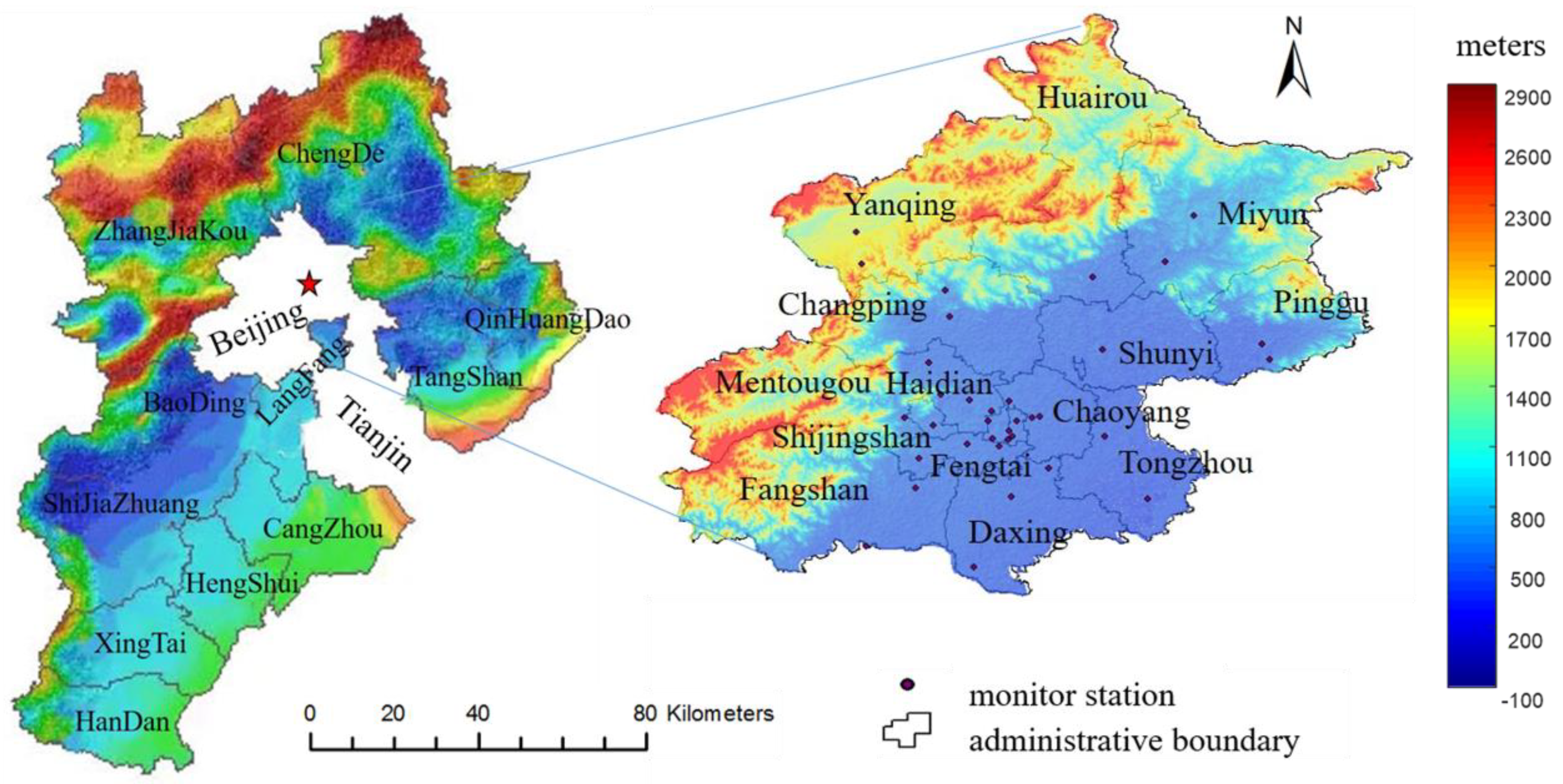
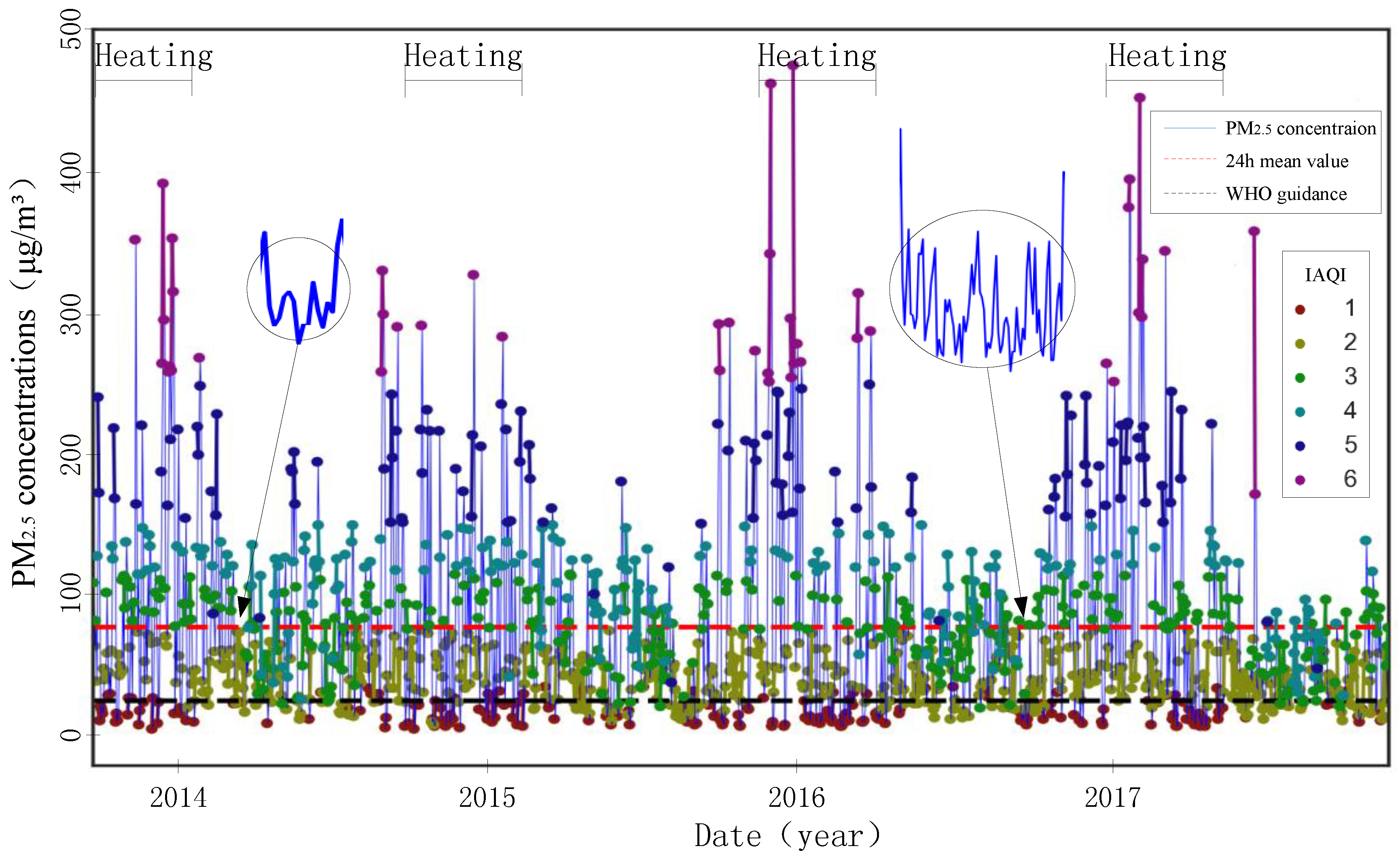
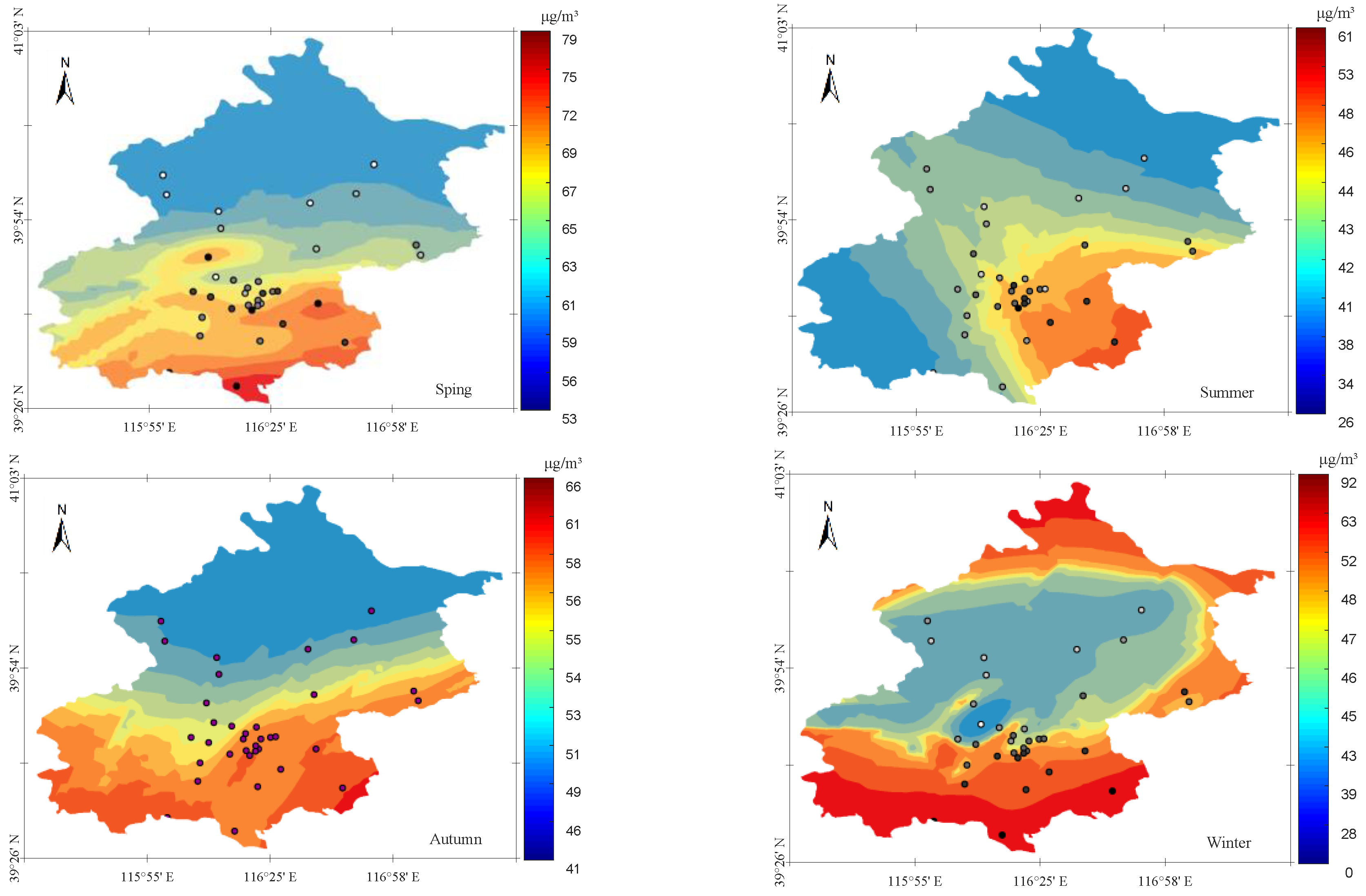
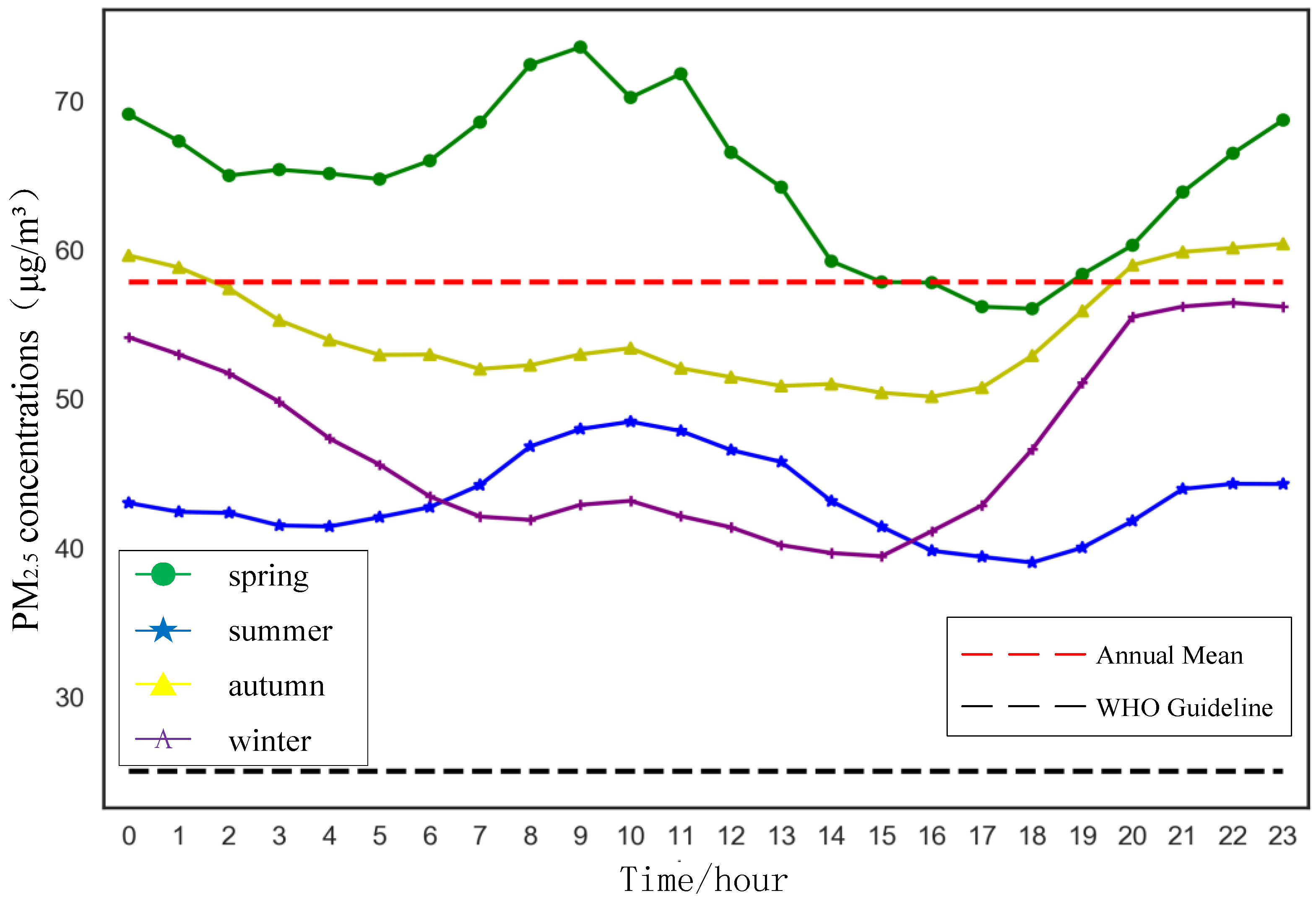
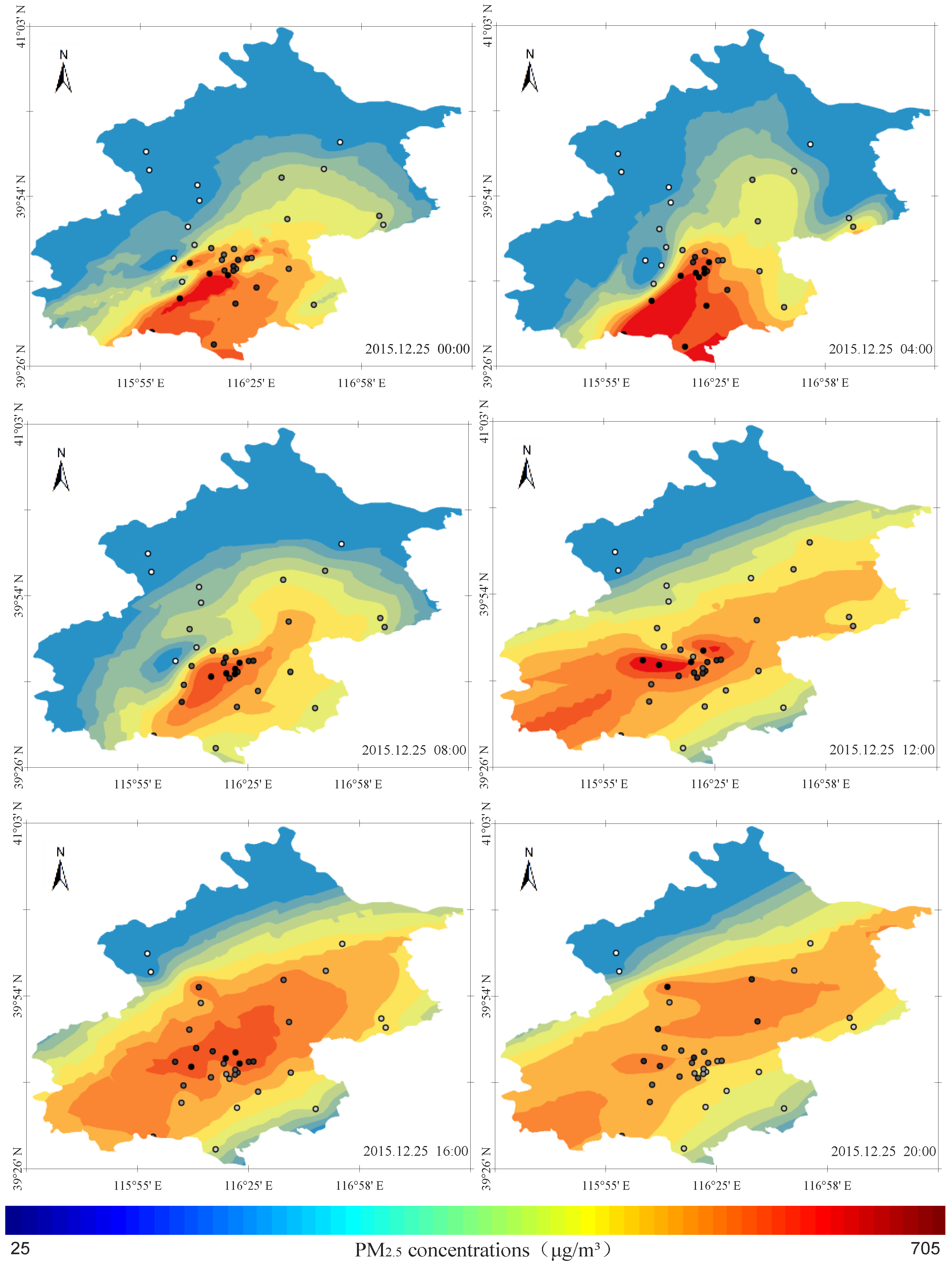
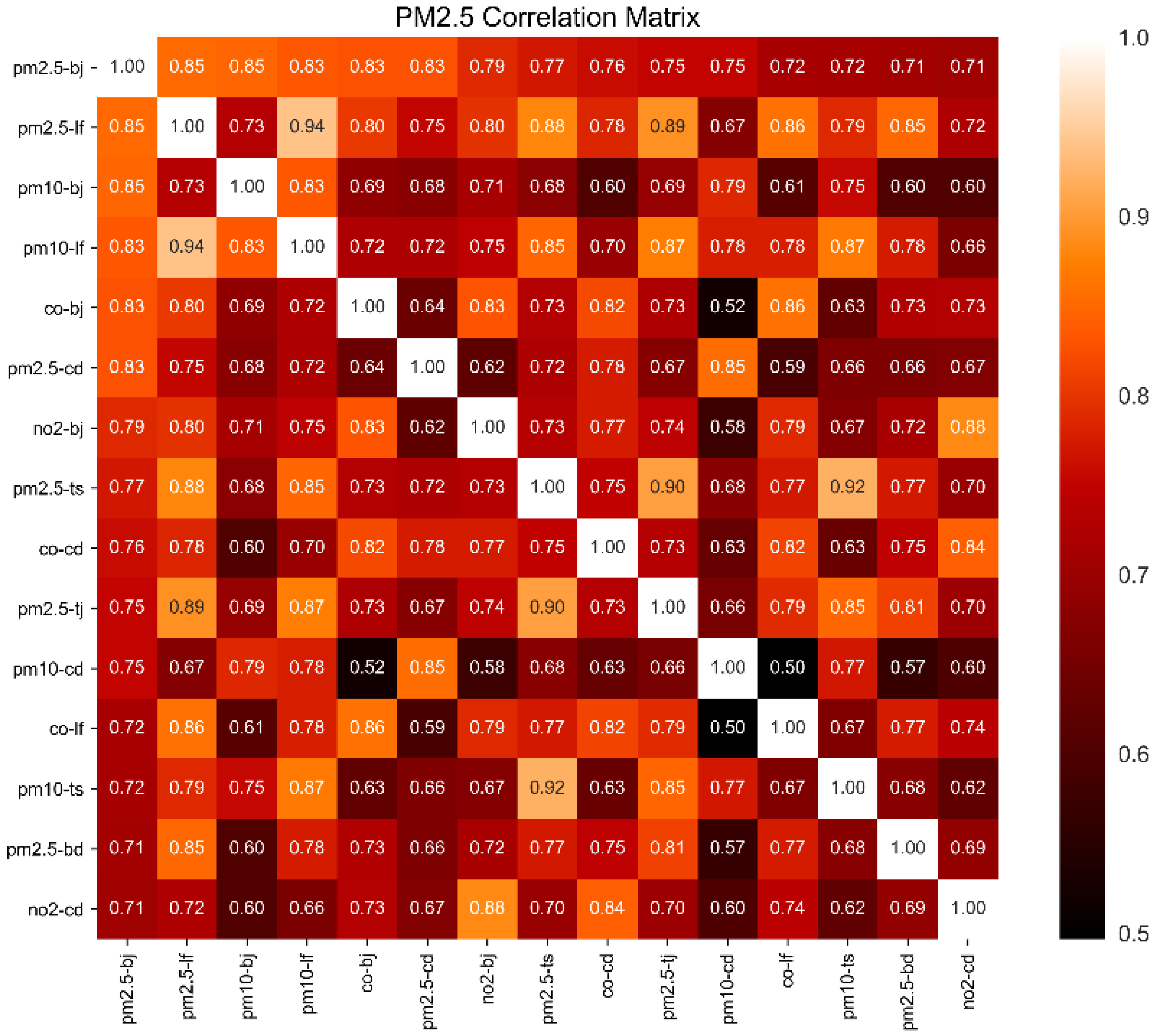
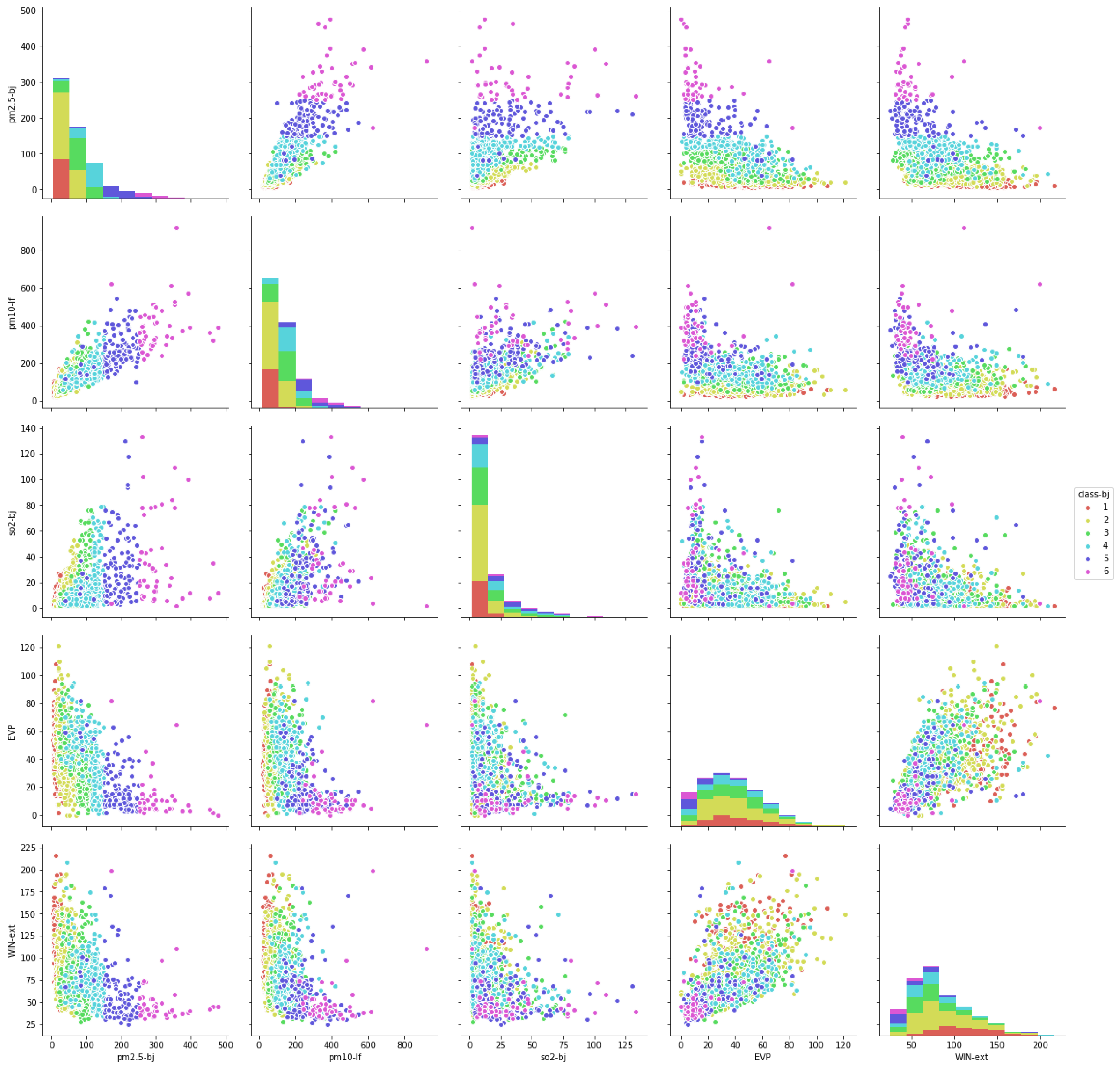
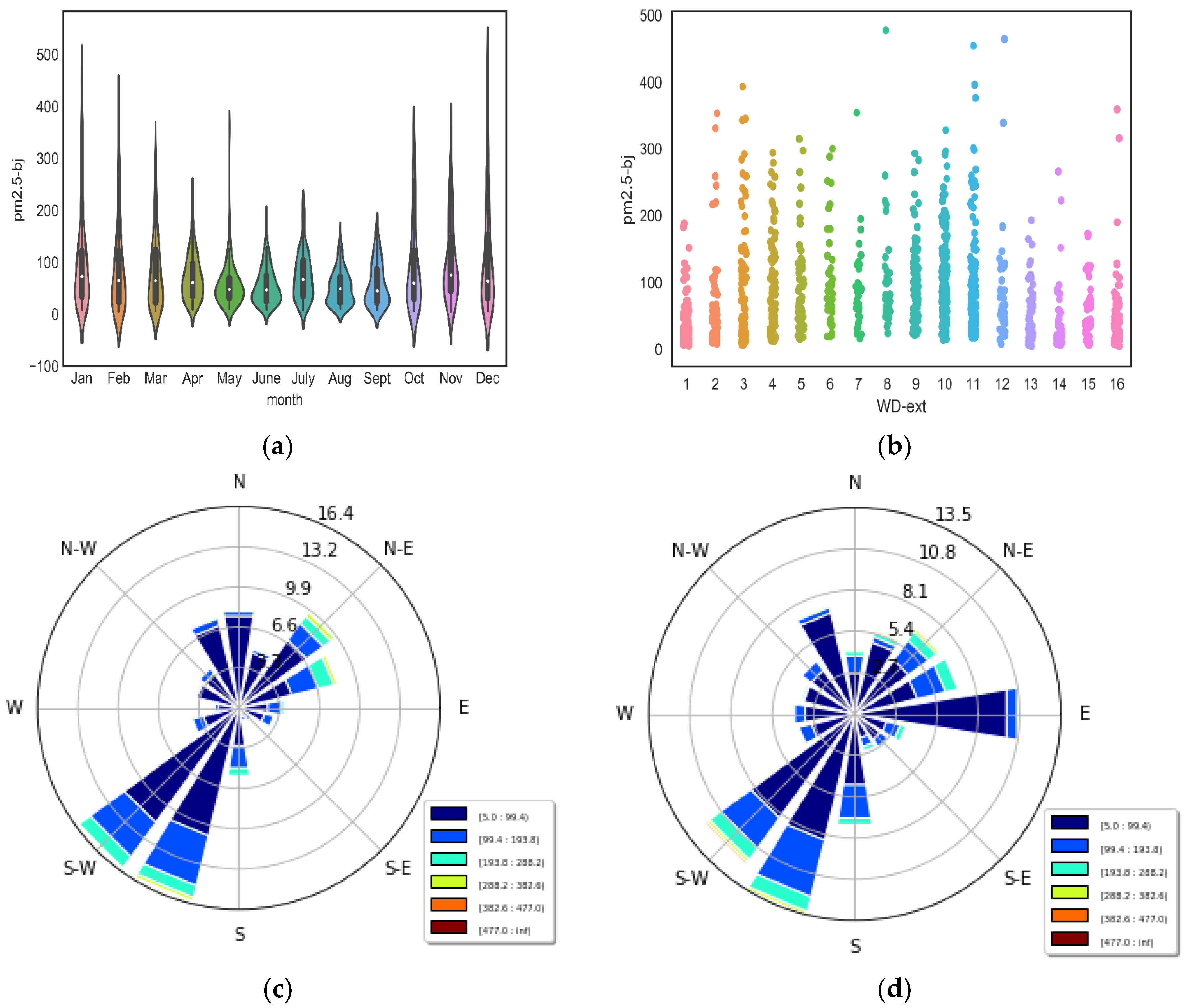
| Parameter | Type * | Unit | Description | |
|---|---|---|---|---|
| Pollutant factors | PM2.5-BJ | N | μg/m3 | Daily averaged concentration of PM2.5 in Beijing |
| PM10-BJ | N | μg/m3 | Daily averaged concentration of PM10 in Beijing | |
| SO2-BJ | N | μg/m3 | Daily averaged concentration of SO2 in Beijing | |
| CO-BJ | N | mg/m3 | Daily averaged concentration of CO in Beijing | |
| NO2-BJ | N | μg/m3 | Daily averaged concentration of NO2 in Beijing | |
| O3-BJ | N | μg/m3 | Daily averaged concentration of O3 in Beijing | |
| AQI-BJ | N | - | Daily air quality index of Beijing | |
| Class-BJ | C | 1–5 | Daily grade of air quality in Beijing | |
| Meteorological factors | EVP | N | 0.1 mm | Daily evaporation capacity of Beijing |
| GST-mean | N | 0.1 °C | Daily averaged ground surface temperature | |
| GST-max | N | 0.1 °C | Daily maximal ground surface temperature | |
| GST-min | N | 0.1 °C | Daily minimal ground surface temperature | |
| PRE-208 | N | 0.1 mm | Precipitation from 20:00 p.m. to 8:00 a.m. | |
| PRE-820 | N | 0.1 mm | Precipitation from 8:00 a.m. to 20:00 p.m. | |
| PRE-2020 | N | 0.1 mm | Precipitation from 20:00 p.m. to 20:00 p.m. | |
| PRS-mean | N | 0.1 hPa | Daily averaged barometric pressure | |
| PRS-max | N | 0.1 hPa | Daily maximal barometric pressure | |
| PRS-min | N | 0.1 hPa | Daily minimal barometric pressure | |
| RHU-mean | N | 1% | Daily averaged relative humidity | |
| RHU-min | N | 1% | Daily minimal relative humidity | |
| SSD | N | 0.1 h | Daily duration of sunshine | |
| TEM-mean | N | 0.1 °C | Daily averaged air temperature | |
| TEM-max | N | 0.1 °C | Daily maximal air temperature | |
| TEM-min | N | 0.1 °C | Daily minimal air temperature | |
| WIN-mean | N | 0.1 m/s | Daily averaged wind speed | |
| WIN-max | N | 0.1 m/s | Daily maximal wind speed | |
| WD-max | C | 1–16 | Wind direction of maximal wind speed in category | |
| WIN-ext | N | 0.1 m/s | Extreme wind speed | |
| WD-ext | C | 1–16 | Wind direction of extreme wind speed in category | |
| PM2.5-bj | PM10-bj | NO2-bj | CO-bj | SO2-bj | O3-bj | |
|---|---|---|---|---|---|---|
| Unit | μg/m3 | μg/m3 | μg/m3 | mg/m3 | μg/m3 | μg/m3 |
| Mean | 77.40 | 104.90 | 50.41 | 1.23 | 14.52 | 97.93 |
| Standard Deviation | 68.43 | 80.86 | 24.38 | 1.01 | 17.01 | 64.70 |
| 25% | 29 | 48 | 33 | 0.60 | 4 | 50 |
| 50% | 58 | 88 | 44 | 0.90 | 8 | 85 |
| 75% | 103 | 135 | 61 | 1.40 | 18 | 138 |
| Range | (5, 477) | (0, 820) | (8, 155) | (0.2, 8.0) | (2, 133) | (2, 294) |
© 2018 by the authors. Licensee MDPI, Basel, Switzerland. This article is an open access article distributed under the terms and conditions of the Creative Commons Attribution (CC BY) license (http://creativecommons.org/licenses/by/4.0/).
Share and Cite
Zhai, B.; Chen, J.; Yin, W.; Huang, Z. Relevance Analysis on the Variety Characteristics of PM2.5 Concentrations in Beijing, China. Sustainability 2018, 10, 3228. https://doi.org/10.3390/su10093228
Zhai B, Chen J, Yin W, Huang Z. Relevance Analysis on the Variety Characteristics of PM2.5 Concentrations in Beijing, China. Sustainability. 2018; 10(9):3228. https://doi.org/10.3390/su10093228
Chicago/Turabian StyleZhai, Binxu, Jianguo Chen, Wenwen Yin, and Zhongliang Huang. 2018. "Relevance Analysis on the Variety Characteristics of PM2.5 Concentrations in Beijing, China" Sustainability 10, no. 9: 3228. https://doi.org/10.3390/su10093228
APA StyleZhai, B., Chen, J., Yin, W., & Huang, Z. (2018). Relevance Analysis on the Variety Characteristics of PM2.5 Concentrations in Beijing, China. Sustainability, 10(9), 3228. https://doi.org/10.3390/su10093228




